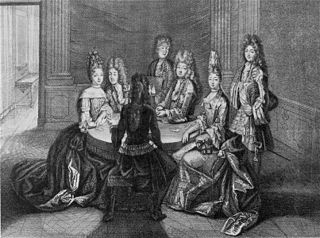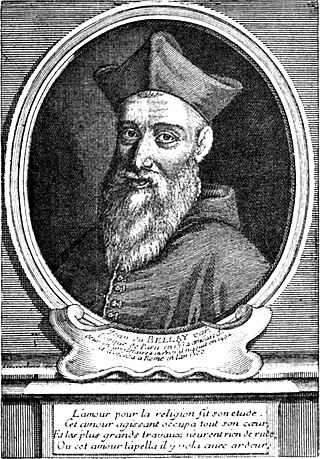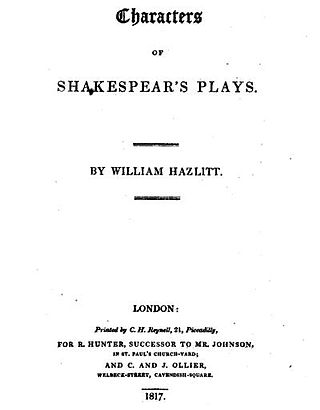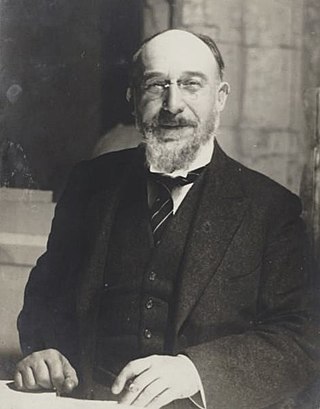Related Research Articles

François Rabelais, has been called the first great French prose author. A humanist of the French Renaissance and Greek scholar, he offended both John Calvin and the hierarchy of the Catholic Church. Though in his day he was best known as a physician, scholar, and diplomat, later he became better known as a satirist, for his depictions of the grotesque, and for his larger-than-life characters.

Lansquenet is a banking game played with cards, named after the French spelling of the German word Landsknecht, which refers to 15th- and 16th-century German mercenary foot soldiers; the lansquenet drum is a type of field drum used by these soldiers. It is recorded as early as 1534 by François Rabelais in Gargantua and Pantagruel.

Jean du Bellay was a French diplomat and cardinal, a younger brother of Guillaume du Bellay, and cousin and patron of the poet Joachim du Bellay. He was bishop of Bayonne by 1526, member of the Conseil privé of King Francis I from 1530, and bishop of Paris from 1532. He became Bishop of Ostia and Dean of the College of Cardinals in 1555.

The Five Books of the Lives and Deeds of Gargantua and Pantagruel, often shortened to Gargantua and Pantagruel or the Cinq Livres, is a pentalogy of novels written in the 16th century by François Rabelais. It tells the adventures of two giants, Gargantua and his son Pantagruel. The work is written in an amusing, extravagant, and satirical vein, features much erudition, vulgarity, and wordplay, and is regularly compared with the works of William Shakespeare and James Joyce. Rabelais was a polyglot, and the work introduced "a great number of new and difficult words [...] into the French language".
This article presents lists of literary events and publications in the 16th century.
This article contains information about the literary events and publications of 1693.

Post and Pair or Post and Pare is a gambling card game that was popular in England in the 16th and 17th centuries — another name of the game was Pink. It is based on the same three-card combinations, namely prial, found in related games of this family.

Ahmad Javad was an Azerbaijani poet who is best known for writing the words of the National Anthem of Azerbaijan used under the 1918–1920 Democratic Republic of Azerbaijan, and again since 1991, and another poem named Chirpynirdi gara deniz. He was later arrested by the Soviet regime and executed on October 13, 1937, accused of trying to spread Musavat-inspired nationalism to young Azerbaijani poets.

Flatulence humor, refers to any type of joke, practical joke device, or other off-color humor related to flatulence.

Ucalegon was one of the Elders of Troy, whose house was set afire by the Achaeans when they sacked the city. He is one of Priam's friends in the Iliad, and the destruction of his house is referred to in the Aeneid.

Characters of Shakespear's Plays is an 1817 book of criticism of Shakespeare's plays, written by early nineteenth century English essayist and literary critic William Hazlitt. Composed in reaction to the neoclassical approach to Shakespeare's plays typified by Samuel Johnson, it was among the first English-language studies of Shakespeare's plays to follow the manner of German critic August Wilhelm Schlegel, and, with the work of Samuel Taylor Coleridge, paved the way for the increased appreciation of Shakespeare's genius that was characteristic of later nineteenth-century criticism. It was also the first book to cover all of Shakespeare's plays, intended as a guide for the general reader.

Maurice Jules Abel Lefranc was a historian of French literature, expert on Rabelais, and the principal advocate of the Derbyite theory of Shakespeare authorship.

Gogmagog was a legendary giant in Welsh and later English mythology. According to Geoffrey of Monmouth's Historia Regum Britanniae, he was a giant inhabitant of Albion, thrown off a cliff during a wrestling match with Corineus. Gogmagog was the last of the Giants found by Brutus and his men inhabiting the land of Albion.

The Tatler was a British literary and society journal begun by Richard Steele in 1709 and published for two years. It represented a new approach to journalism, featuring cultivated essays on contemporary manners, and established the pattern that would be copied in such British classics as Addison and Steele's The Spectator, Samuel Johnson's The Rambler and The Idler, and Goldsmith's Citizen of the World. The Tatler would also influence essayists as late as Charles Lamb and William Hazlitt. Addison and Steele liquidated The Tatler in order to make a fresh start with the similar Spectator, and the collected issues of Tatler are usually published in the same volume as the collected Spectator.

The Trois petites pièces montées is a suite for small orchestra by Erik Satie, inspired by themes from the novel series Gargantua and Pantagruel by François Rabelais. It was premiered at the Comédie des Champs-Élysées in Paris on February 21, 1920, conducted by Vladimir Golschmann. Satie later arranged it for piano four hands and today it is more frequently heard in this version. A typical performance lasts about five minutes.

Trictrac is a French board game of skill and chance for two players that is played with dice on a game board similar, but not identical, to that of backgammon. It was "the classic tables game" of France in the way that backgammon is in the English-speaking world.

An Ace-Ten game is a type of card game, highly popular in Europe, in which the Aces and Tens are of particularly high value.

Losing Lodam is an historical English card game for three or more players. It is a 'negative' game like Hearts whereby the aim is to avoid taking tricks with certain cards known as loaders.

Tourne Case or Tourne-Case is an historical French tables game in the same family as Backgammon. Lalanne recommends it as a children's game.

Doublets or queen's game is an historical English tables game for two people which was popular in the 17th and 18th centuries. Although played on a board similar to that now used for backgammon, it is a simple game of hazard bearing little resemblance to backgammon. Very similar games were played in mainland Europe, the earliest recorded dating to the 14th century.
References
- ↑ Quinion, Michael. "Left in the Lurch". World Wide Words. Retrieved 9 January 2020.
- ↑ Furetière (1727). Lourche entry.
- ↑ Skeat (1893), p. 262
- ↑ Grimm & Grimm (1885), p. 1314
- 1 2 Murray (1952), p. 124.
- ↑ Rabelais (1534), p. 403
- ↑ Brand and Hazlitt (1870), p. 339.
- ↑ Shakespeare (1893), p. 302
- ↑ Addison (1892), p. 179.
- ↑ Godefroy (1888), p. 666.
- ↑ Johnson (1765), "Lurch".